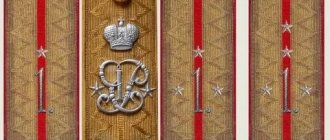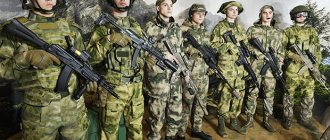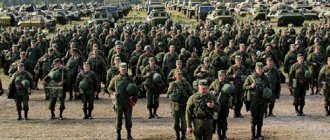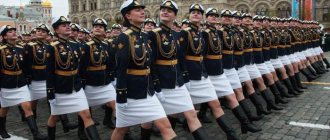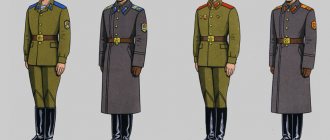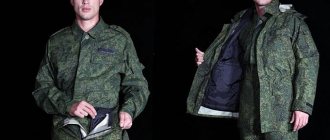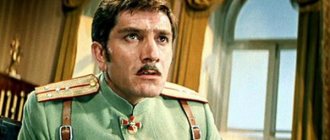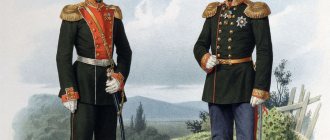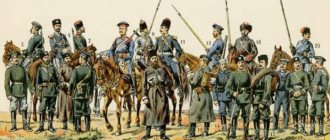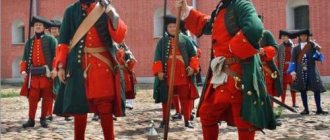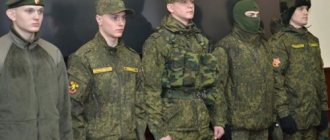As incentives for the activities of employees and employees of the Federal Border Guard Service of the Ministry of Emergency Situations of Russia, they may be awarded state and departmental awards. Also, employees have sleeve insignia that determines their belonging to the Ministry of Emergency Situations of Russia and to specific structural units (central office, main departments, special departments, fire and rescue units, etc...).
The rules for placing awards, breastplates and sleeve insignia on the uniform of employees of the Ministry of Emergency Situations are established by Order of the Ministry of Emergency Situations of the Russian Federation dated July 3, 2008 N 364 “On approval of the Rules for wearing uniforms by employees of the State Fire Service of the Ministry of the Russian Federation for Civil Defense, Emergency Situations and Elimination of Consequences of Natural Disasters disasters, having special ranks of internal service" (hereinafter - Order No. 364), and in their principles they are similar to the rules for employees of other law enforcement agencies of the Russian Federation.
Caring for the uniform and rules for wearing it
According to the rules established by Order of the Russian Minister of Defense No. 300 of June 22, 2015, military uniforms (office suits) must always be clean.
In this regard, it is important to know some of the features of caring for military uniforms
Military uniforms require careful care. This is due to the fact that improper drying or washing can greatly spoil the appearance of things, which can result in serious problems in service.
Before washing and cleaning, you should carefully read the information on the label. Wool clothing requires hand washing in warm water. If this is not possible, you can machine wash it, choosing the most gentle mode. If you use hot water when washing woolen items, they may shrink in size. It is strictly forbidden to squeeze such products.
There are no such increased requirements regarding the care of everyday military equipment. It does not deteriorate when washed in a machine using any mode and any type of powder. You can use any water temperature for cleaning. Such reduced care requirements are due to the high quality of the uniform materials.
It is not advisable to clean beautiful formal clothes at home. To do this, it is better to take the help of dry cleaning professionals. They are much more experienced and know well the features of caring for various types of things.
The 2022 innovations regarding military uniforms are distinguished by an increase in the quality and comfort of uniforms. Russian military clothing is currently considered one of the best in the world. In addition, during special military operations it is supplemented with modern elements that help increase the combat effectiveness of soldiers.
VKPO kit
Currently, the army and navy have adopted the concept of multi-layer clothing, which is used in the temperature range from +15°C to -40°C and consists of:
| Layer No. | Underwear | Outerwear clothing |
| 1 | Lightweight | — |
| 2 | Lightweight or fleece (insulated) | — |
| 3 | Lightweight or fleece (insulated) | fleece jacket, trousers, boots, cap. |
| 4 | Lightweight or fleece (insulated) | fleece jacket, trousers, boots, cap, windbreaker jacket. |
| 5 | Lightweight or fleece (insulated) | fleece jacket, trousers, boots, cap, demi-season suit. |
| 6 | Lightweight or fleece (insulated) | fleece jacket, trousers, boots, cap, windproof suit. |
| 7 | Lightweight or fleece (insulated) | fleece jacket, trousers, boots, insulated vest, balaclava, gloves. |
| 8 | Lightweight or fleece (insulated) | fleece jacket, insulated pants, insulated boots, hat, mittens, balaclava. |
Fleece underwear with lint inside can be worn over regular underwear in low temperatures. Underwear and jackets are made from breathable fabric that retains body heat, wicks away sweat and prevents cold from penetrating under clothing.
In places where increased loads are applied to the material, reinforcement components are inserted and additionally stitched.
For operations in conditions of rain and high humidity, a special suit is used, the fabric of which does not get wet and does not allow moisture to pass through, the seams are treated with glue.
In cold weather, use an insulated jacket with a hood, the fabric of which repels water, has windproof properties and retains heat.
The hat with earflaps has flaps that wrap under the chin, creating additional insulation for the face. It is allowed to wear a balaclava under a hat.
At temperatures above +15°C, use a lightweight version of underwear with short sleeves and shorts, and a summer field suit. Clothing absorbs sweat well, dries quickly, is breathable and is easy to wash.
Uniform kits for wearing at different temperatures
The new military uniform in the Russian Federation is presented in two sets: basic and multi-layer. The basic uniform is considered to be used by soldiers at temperatures from +16 ˚С and above.
The multi-layered form of the uniform was intended to be worn at temperatures from +15 ˚С to -40 ˚С. In winter, soldiers used fleece underwear or a lightweight version of it. The choice of things depends on the temperature indicators. During particularly cold seasons, both sets can be worn together.
Summer equipment included a jacket, trousers, boots and beret. The entire surface of things was carefully treated with a new solution that repels moisture. When a soldier was in the rain, his clothes remained dry for up to two hours.
Protection against various mechanical influences was used in the form of reinforcing elements. This type of kit is used in military units with a high degree of danger and load.
New rules for wearing military uniforms allow the use of a fleece jacket in the fall. It provides good thermal insulation due to high-quality pile covering this item of clothing on both sides. In strong winds, wear a special windbreaker jacket, complemented by fifth-layer trousers.
For the autumn-spring period, demi-season military suits are also provided, the tailoring of which uses special material. It provides reliable protection for soldiers from the wind, provides a high level of vapor permeability, and allows them to dry quickly after getting wet.
If there are heavy downpours, military personnel are allowed to use a wind- and waterproof army uniform kit, which is supplemented with a special membrane and special sizing of layers that provide a high degree of water resistance.
Insulated jackets and vests have been developed for the winter season to protect against wind and moisture. They are made of lightweight material that retains good protective properties while being light and practical. At extremely low temperatures, insulated hats and balaclavas are used.
Field
This type of military uniform is required:
- for educational events;
- during hostilities;
- during training;
- in combat;
- when a state of emergency is declared;
- to eliminate the consequences of disasters, accidents and other disasters.
The Minister of Defense of the Russian Federation, Army General Sergei Shoigu, approved a new model of the field uniform, pointing out a number of improvements, since the previous uniform did not meet the requirements in many respects. Examples of this can be found in numerous pictures presented on the Internet. At the moment, testing of clothing is taking place in the troops themselves.
The main feature of the latest field uniform for military personnel is that it is multi-layered. Previously, only field equipment for special forces units was manufactured using this principle.
The VKBO includes 23 items of clothing, which also include three pairs of shoes. The combination of eight layers of clothing allows military personnel to use this field uniform in the off-season and winter, that is, when the temperature ranges from + 15 to – 40 degrees Celsius.
The field uniform includes eight layers of clothing, which include the following items:
- Lightweight underwear;
- Fleece underwear;
- Fleece jacket;
- Windbreaker;
- Demi-season suit;
- Windproof suit;
- Insulated vest;
- Insulated suit.
Thus, the combination of different layers is selected depending on the weather and the intensity of physical activity experienced by officers and soldiers. But if the air temperature is more than fifteen degrees, then a summer field uniform is required.
LightweightFleece
Fleece jacket
Windbreaker
Demi-season
Windproof Vest
Insulated
Summer
The new sample summer field uniform includes the following items of clothing:
- lightweight jacket;
- light boots;
- beret or cap;
- trousers.
In the manufacture of this uniform, stretch is used, which is first treated with a water-repellent compound. When it comes to parts with the greatest load, the application of reinforcing components is required, which protects the suit from mechanical damage and the degree of wear becomes minimal.
When service takes place in cooler conditions, it is required to wear a component of a military uniform, namely a fleece jacket, which has thick pile on both sides of the product. The jacket has a durable layer of thermal insulation, but, if necessary, it can be easily rolled up and will take up minimal volume. In windy weather, use a windbreaker jacket, which is worn together with trousers.
JacketBoots
Beret
CapPants
Winter
In cool weather, you will need to wear a military uniform such as a demi-season set, which reliably protects from the wind. The fabric of the suit allows steam to pass through perfectly, but at the same time it dries quickly. In special situations, waterproof clothing is required, even the seams are taped with a special glue.
During severe frosts, a more insulated suit and vest are required, which are quite light but practical. The winter field uniform is made from waterproof materials that also protect from the wind. In cold weather, you are allowed to use a balaclava, which is worn as a hat or together with it.
Jacket
Trousers
HatBalaclava
New military field uniform
The new uniform was developed partly in 2010, when soldiers began wearing fitted overcoats with Velcro, which made them quicker to put on and secure to the body. The military also has winter versions of sweaters.
New versions of the uniform were developed taking into account the feedback and wishes of thousands of Russian soldiers. The existing uniform became multi-layered, which allowed each soldier to choose the elements he needed independently, taking into account the tasks and goals assigned to him, as well as weather conditions.
The updated set of military uniforms included a basic suit, several types of jackets, shoes for each season of the year (boots of different types), a belt made of synthetic material, good quality socks and many other items of uniform. The uniform material was a mixed fabric (65% cotton and 35% polymer-type materials).
A complete change of military equipment took place over three stages, which lasted from 2013 to 2022. One of the most important innovations was the replacement of foot wraps with socks (twelve pairs for each soldier for one year). This figure is planned to be doubled in the near future.
Equipment for the dress uniform of Russian military personnel
For all categories of military personnel of the RF Armed Forces, dress uniforms are required to be equipped with established insignia: shoulder straps, sleeve patches, breast insignia (badges, medals, orders). At the same time, lapel insignia, which had long been preserved as a traditional element of military uniform according to the Soviet model, underwent serious reform. Since 2018, the officers of the Russian Army are similar in appearance to the historical buttonholes of the Russian Guard of the 19th century.
Lapel emblems are intended to be worn only by the officer corps of junior and senior ranks (from junior lieutenant to colonel inclusive). For the Navy, lapel insignia in the form of an anchor were installed. The senior officers of the RF Armed Forces wear lapel emblems with the image of a laurel branch (army generals - in the form of an oak branch).
Placement of insignia
The sleeve insignia reflects affiliation both with the RF Armed Forces as a whole (as a difference from military personnel in the structures of the Ministry of Internal Affairs, the Federal Penitentiary Service, VNG, etc.), as well as directly with the branches (branches of troops) of the Armed Forces. In addition, it is required to design the serviceman’s ceremonial uniform with sleeve insignia according to his affiliation with specific military formations, in the absence of which insignia are placed according to the affiliation of a higher military command authority (military formation).
| Types of signs | Placement |
| Patch indicating affiliation with the RF Ministry of Defense, forces of the RF Armed Forces, branches of the RF Armed Forces | On the left sleeve |
| Patch indicating affiliation with specific military formations | On the right sleeve |
| State and departmental awards, special insignia (orders on blocks and medals) | On the left side of the chest |
| Insignia of the RF Armed Forces and awards (orders, badges of honor) with a special status | On the right side of the chest |
On the right lapel of the jacket, in particular, are worn commemorative insignia of the Ministry of Defense of the Russian Federation, insignia of class qualifications of specialists of the Armed Forces, the commander of a ship (submarine), and also on the right side of the chest are placed (in order of priority) the following insignia:
- "Guard";
- Graduation from a military or state professional educational organization;
- Graduated from Suvorov Military, Nakhimov Naval, and Military Music Schools.
This is followed by the badge “Excellence in the service (branch) of the Armed Forces”, etc. insignia to denote merit shown in the performance of official and special duties, high achievements of military personnel in various types of daily activities (including sports), their high combat and professional qualities.
Location of medals
The location of medals on full dress uniform in the RF Armed Forces is established by Order of the Minister of Defense of the Russian Federation dated June 22, 2015 No. 300, which determines the sequence of placement of all state and departmental awards on full military uniform. Orders on blocks and medals are placed on the left side of the chest horizontally in a row from the center of the chest to the edge, from top to bottom in the order listed. When wearing two or more orders or medals on the left side of the chest, their blocks can be connected in a row on a common bar (the upper sides of the blocks are adjacent to each other, forming a straight line without breaks, and each block located on the right partially covers the block located to the left) .
Orders and medals that do not fit in one row are transferred to the second and subsequent rows, located below the first, also placing them from the center of the chest to the edge in the above order. The blocks of orders and medals of the second row should go under the orders and medals of the first row, while the lower edge of the medals of the upper row and the upper edge of the medals of the lower row should be located at the same level. Subsequent rows are arranged in a similar order.
Author of the article:
Nikiforov Vladislav
Reform in matters of uniform of the Russian army
Before the Order of the Ministry of Defense of the Russian Federation came into effect, military uniforms were repeatedly changed and improved: since 2007, competitions for the submission of sketches of new options were announced to make changes to the uniform of military personnel. The final models chosen for development were the models of the famous Russian designer V. Yudashkin.
Until 2009, these sketches were refined and improved, as a result of which a uniform of the Russian Armed Forces was developed, similar in appearance to the American one. The winter version was not suitable for the military personnel, since it did not protect them from the cold and quickly became unusable.
After receiving numerous complaints from soldiers, as well as a sharp outbreak of an epidemic of colds due to hypothermia in the military, the Ministry of Defense decided to again review the established uniforms (in particular, winter kits and field options).
History of military uniforms
It is necessary to make some digression and talk about the uniform of soldiers of the Soviet Army in the period after the end of the Great Patriotic War until the collapse of the Soviet Union.
The Great War influenced the uniform of soldiers and sergeants in terms of adaptation to the difficult conditions of military reality. The tunic with pockets and a straight-cut stand-up collar was belted with a leather belt with a stamped buckle. The khaki-colored buttons and buckle made the uniform a field uniform, while the gilded ones made it an everyday uniform. Breeches were tucked into boots.
The khaki-colored ceremonial uniform was similar to an officer's uniform, but was made from cheaper fabrics, without trim, and with cloth buttonholes. Trousers and breeches were sewn without edges.
In 1947, Airborne Forces soldiers received a special diamond-shaped badge on their right sleeve, which was attached to their everyday and dress uniforms.
The year 1956 was marked by the introduction of the Rules for Wearing Military Uniforms with the simultaneous replacement of old models. The everyday uniform has become more comfortable and practical: a tunic with patch pockets and breeches with boots, a cap on the head, and a star on the cap.
Soldiers who served in hot climates had an opening collar on their tunic and a Panama hat instead of a cap. In 1961, it was allowed to wear boots instead of boots, and shorts instead of trousers.
Field equipment with shoulder straps and a backpack were introduced; for participation in work events, pea coats were issued (insulated with cotton wool in winter).
The dress uniform was also simplified, the piping and back pockets disappeared, but colored buttonholes and a cap band with a star remained.
A radical change in the uniform of conscript soldiers occurred in the late 60s of the last century. Everyday clothing resembled a closed officer's field jacket (in summer - cotton, in winter - cloth), color - khaki, buttonholes - colored, brass buttons and emblems, shoulder straps - colored without letters, cap with a colored band and cockade, khaki-colored breeches in boots, leather belt with buckle.
Airborne soldiers wore a blue and white vest, a jacket with the top button undone, and a blue beret with a cockade.
The khaki dress uniform included:
- open uniform, colored buttonholes with emblems of the military branches, colored shoulder straps with brass letters “SA”, chevron on the left sleeve;
- long sleeve shirt and tie;
- trousers;
- a cap with a colored band and cockade;
- leather belt with stamped buckle.
In winter, the soldier wore a single-breasted overcoat, which was, as they say, “for all occasions”: for the parade, for everyday wear and for going out into the field. Four brass buttons were attached to it, colored shoulder straps with the letters “SA” and a sleeve chevron were sewn on. A red metal star was attached to the earflap hat.
The casual jacket was also used for field trips. Instead of a cap, they wore a cap with a red star, and the badges received by the soldier, field equipment and a helmet were placed on the jacket.
The work uniform remains the same. Chevrons, cap bands, shoulder straps and buttonholes must be the same color and indicate affiliation:
- red - motorized rifle troops, musicians and military conductors;
- blue – pilots and paratroopers;
- raspberry – medical and veterinary services;
- black - the rest of the military branches.
Specialization was designated by emblems in the buttonholes of the branch of the military where the soldiers served.
Conscript sailors wore black uniforms, vests and short boots. The uniform was divided into winter and summer; in hot climates, a blue jacket with short sleeves and shorts was used, and a cap was worn on the head.
In 1973, new Rules for wearing military uniforms were introduced.
The following has changed for conscript soldiers:
- a bleached belt with a gilded buckle was added to the dress uniform;
- stripes for years of service were attached to the right sleeve;
- the letters “SA” appeared on all shoulder straps;
- belt with a khaki-colored buckle for the field uniform;
- In addition to the parade uniform of the Airborne Forces, they were allowed to wear a blue beret and a vest under the jacket.
The next leap in shape change occurred during the war in Afghanistan. The field uniform caused fair criticism: it was uncomfortable and not suitable for fighting in the mountains. Trousers and laced boots began to be introduced, shiny parts (buttonholes, emblems, cockades) were replaced with field ones (khaki color). Camouflage equipment has become widespread.
In general, by the end of the 80s, the cotton “Afghan” uniform with patch pockets, khaki-colored elements, a cap and trousers in combination with unloading vests, which served as some protection for the soldier, became widespread.
On the uniform of military personnel of the Russian Armed Forces
The Russian Ministry of Defense has worked very carefully on the issues of creating and wearing the uniform. The modern form differs not only in color, but also in purpose. There are three forms of clothing: casual (office), field and dress. These types of clothing are also divided into winter and summer sets.
Another distinctive feature of the uniform of the Russian military is its color design, which makes it possible to determine whether a serviceman belongs to a particular branch of the military. Thus, it is typical for officers and sailors of the Russian Navy to wear a black uniform, for military personnel of the Ground Forces - green, and for the Aerospace Forces and Airborne Forces - blue.
However, it is not only by the color of the uniform that one can determine which branch of the military a soldier belongs to. In the Russian army there is a system of sleeve insignia for the formations of the Russian Armed Forces. Such emblems are made in the form of rectangular shapes with the image of the coat of arms of the Russian Federation on a colored background. Each type of military has its own color.
Also included as insignia are lapel insignia. The purpose of the buttonholes is to determine whether a serviceman belongs to certain types of troops. The buttonholes are attached to the military officer's collar and the top of the shoulder straps.
Among other things, insignia include divisional emblems made in the form of stripes. They are placed on the right sleeve and are mandatory for all personnel of a particular military unit.
Now let’s take a closer look at the uniform sets.
The everyday (office) uniform consists of a jacket and trousers in green, blue or black, a headdress (for privates - a cap or beret, for officers - a cap) and standard combat boots for soldiers and black boots for non-commissioned officers and officers.
The field uniform is a set consisting of a headdress (cap/beret/hat), a khaki suit and army shoes. This set is the same for both privates and officers.
The dress uniform includes a headdress (usually a cap), a jacket and trousers, and a white shirt is worn under the jacket. Also a mandatory attribute until 2022 was a black tie with a gold-colored clip. And starting from the 17th year, the dress uniform of the Russian Armed Forces has undergone significant changes and began to resemble that of Soviet times. Shoes are chosen to be black. For officers of the Russian Navy, a mandatory attribute of their dress uniform is a naval dagger.
It is also worth noting that civilian personnel of the Russian Ministry of Defense have their own uniform. Outwardly, it is similar to the military one and differs only in the color of the stars and gaps on the shoulder straps. For civilian personnel they are silver-white.
Military uniforms and insignia in the Ministry of Defense of the Russian Federation are regularly changed, so with the next innovations we will definitely notify you with fresh material.
Property safety
Uniforms and underwear will last the required time if you treat them with care. Sergeants and soldiers store their uniforms in the unit's dormitory or storeroom. These servicemen carry one set of clothes and shoes in their socks.
The work uniform is placed in special lockers. Winter clothes hang in the hallway or in a specially designated area on hangers. The rest of the uniform is given a place in the unit's storeroom. Ironed, with clean collars, ties fastened to shirts, it is on hangers, and hats are in special slots.
The foreman is responsible for issuing linen and clothing from the company's pantry. Those living in the barracks receive one copy of a blanket, a pillow, and a set of bed linen consisting of a pillowcase and 2 sheets. In addition, the recruit is given 2 towels for wiping his face and feet, and slippers. Pillows and blankets are selected according to color and size. A bedside rug was provided for those living in the barracks.
During sleep, the uniform is neatly folded onto a stool standing near the bed. In a duffel bag or backpack, a serviceman keeps a bowler hat, a mug, a spoon, threads, a set of buttons and hooks. Before leaving for training, one combat ration, a raincoat, a helmet, a towel, and spare socks or foot wraps are placed in the backpack.
What remains in property upon retirement
After a year of service, sergeants and soldiers retiring into the reserve receive ownership of:
- hats;
- demi-season jacket;
- casual suit with long sleeves;
- a T-shirt, and paratroopers - a vest;
- underwear;
- gloves;
- high-top boots for summer;
- a bag for carrying items of clothing;
- toiletry case with personal hygiene products.
After service, petty officers and sailors also have a cap, ribbons, a uniform collar, and a black muffler. After transfer to the reserve, it is prohibited to transfer military clothing to third parties. You can wear the uniform to festive events and parades.
Everyday uniform of military personnel
The color of the daily uniform depends on rank and affiliation. Military clothing of the Russian Army of the everyday type for generals and officers is olive-colored, in the Air Force it is blue. The caps match the color of the equipment. The color scheme was based on the 1988 model. Decorative elements on the caps are painted gold. Winter clothing for men has not changed since the last reform.
Girls in military uniform can now feel comfortable. Dresses and skirts fit comfortably around the body, highlighting feminine beauty. Women's military clothing - olive or blue. In the winter season, a short, fitted coat is used. Female sergeants and enlisted men wear an olive casual uniform. In the warm season, there should be a cap on the head, in the winter - an astrakhan beret, introduced by the latest reform.
Sergeants, soldiers and cadets are deprived of their daily uniform due to uselessness. As an alternative, they are encouraged to wear winter or summer field equipment.
The military uniform of this type in the winter includes a gray coat for military personnel (blue for the Air Force and Airborne Forces). For the autumn period there is a blue demi-season jacket, for rains in the summer - an elongated raincoat that does not allow moisture to pass through. Black coloring for additional clothing items (belt, boots and socks).
Modern office uniform of the Russian army
This set of clothing is a type of casual clothing, used by generals, officers and employees of the Ministry of Defense of certain ranks. A military suit of this type resembles the everyday clothes of the Ministry of Emergency Situations. The kit includes:
- Soft cap. All military units have a green beret; airborne units were left with a blue beret;
- A cap-colored shirt with long or short sleeves (the choice depends on the weather). Shoulder straps can be attached to the shoulders with Velcro; a tie is not applicable;
- White T-shirt (worn under the shirt);
- Cap-colored trousers and straight-cut shirts.
In the cold season, it is acceptable to use a warm jacket with an office uniform. It is possible to additionally attach a hood. The cap can be replaced with a warm hat with earflaps. Shoulder straps are attached to the shoulders of the suit with Velcro.
Every year the office uniform undergoes minor changes. These include the introduction and abolition of various sewing costumes, changing the shape of insignia, etc. It is prohibited to use an office suit as a field suit. Care and rules for wearing a military uniform
The rules for wearing military uniforms are regulated by Order 1500 - the suit must always be clean. In order for it to remain so, you need to know about some of the intricacies of caring for it. Improper washing or drying can ruin the appearance, which will lead to operational problems. Before cleaning clothes, you should read the information on the label.
It is recommended to wash woolen clothes by hand in warm water. If this is not possible, then you can use a washing machine, but the washing mode should be the most gentle. Military clothing sizes may become smaller if washed using hot water. It is prohibited to wring wool products.
Everyday military equipment is less demanding to care for. It can be washed in a washing machine in any mode with any washing powder. In addition, the casual suit can withstand water of any temperature.
https://youtube.com/watch?v=q7QNxqSbSPo
Author of the article:
Nikiforov Vladislav
Everyday uniform of military personnel
The color and appearance of the daily uniform of the Russian Armed Forces depends on the affiliation and rank. The uniform of Russian military personnel for everyday wear, both officers and generals, is olive in color, while that of air force soldiers is blue. The color of the caps matches the color of the main equipment.
The color base was established according to the shape of the 1988 sample. Decorative elements on clothing are painted gold. Winter men's hats have been preserved since the last reform.
For girls, the military uniform has been developed in an improved version. Skirts and dresses are designed to fit the body comfortably and highlight the beauty of women. For the fair sex, the color scheme includes blue and olive.
Winter women's casual sets include fitted cropped coats. Privates and sergeants wear olive-colored casual uniforms. In the winter season, a special beret is worn on the head, in other seasons - a cap.
There is no daily uniform for soldiers, sergeants and cadets. They usually wear field summer or winter equipment. In winter, it is required to wear a gray coat (the Airborne Forces and the Air Force wear blue coats). The wearing of a demi-season blue jacket is established for the autumn period. In the summer and rainy autumn-spring period - long-cut boards that do not allow moisture to pass through. Socks, boots and a belt, as additional items of clothing, are black.
Dress uniform for military personnel
The parade uniform of the Airborne Forces consists of:
- camouflage trousers and an open jacket;
- vests with blue stripes;
- aiguillette and white gloves (at the parade);
- blue beret;
- waist belt;
- ankle boots on the legs.
The ceremonial set of VKS soldiers: a suit (blue or khaki) is complemented by a shirt with a tie of the same color and a cap. He wears a gold belt and wears boots on his feet.
A sailor's dress uniform consists of:
- black wool trousers with a waist belt;
- white uniform shirt with a collar at the top (blue flannel);
- vests underneath;
- white cap;
- white gloves;
- boot or ankle boot;
- in cold weather - a pea coat (overcoat) with a white muffler and a black hat.
The dress uniform of Russian Guard soldiers consists of an open jacket, vest, trousers tucked into high boots, a white belt and gloves (in parade), a green or maroon beret with a cockade.
The dress uniform of conscripts of the Ground Forces has remained virtually unchanged since Soviet times:
- woolen jacket and trousers for graduation;
- protective shirt with tie;
- belt;
- white gloves and aiguillette (in the parade);
- black boots with black socks;
- colored shoulder straps;
- cap.
Modern office uniform in the army
This type of kit is considered a type of daily uniform. It is used by officers, generals and members of some ranks in the Department of Defense. The set includes items of clothing that together resemble the everyday uniform of the Ministry of Emergency Situations.
The set includes the following clothing items:
- Soft cap. The color for military personnel of any unit is green (excluding airborne units, whose headgear is a blue beret).
- A shirt to match the cap with short or long sleeves (depending on weather conditions), shoulder straps are attached to the shoulders with Velcro, a tie is not used, a white T-shirt (under the shirt).
- The trousers match the shirt and cap, the cut is straight.
- A warm jacket in the cold season with the possibility of additionally attaching a hood, the cap can be replaced with a warm hat (earflaps) if desired, and Velcro with shoulder straps are attached to the suit.
Every year, small changes are made to the office uniform of military personnel that are difficult to notice with the naked eye. The differences are most often of an internal nature (the abolition and introduction of different types of cut and tailoring of suits, changing the shape of distinctive signs, and so on).
The law establishes that wearing office suits as field suits is strictly prohibited. Wearing office-type uniforms should be neat and require minimal care.
Damage and loss
Violation of savings rules leads to the loss of property by military personnel. The Charter states that soldiers and officers must know how to take care of military property and equipment. If things issued to a serviceman are lost or become completely unusable, then he bears financial responsibility for this according to the law.
Punishment may be sent to a disciplinary battalion for 3 or more months. The Disciplinary Regulations are applied when a serviceman voluntarily compensates for the damage caused. There will be no corpus delicti if the loss of uniforms or their damage occurred through no fault of their owner. After all, even if it is properly stored, it can be stolen.
But when a soldier or officer leaves his belongings unattended and they are stolen, then responsibility for the loss is not removed from him. When loss or damage to property occurs in wartime, during hostilities, the public danger increases.
And then the culprit is punished with imprisonment from one to 3-5 years. The punishment will be more severe if the uniform or equipment is sold to another person or pledged. In addition to disciplinary action, it is possible that a criminal case will be opened. Therefore, soldiers must take seriously the property issued during service and take care of it.
Providing uniforms
Provide conscripts with uniforms upon arrival at their duty station. The summer kit is issued until May 15, the winter kit – November 15. Military personnel receive items whose dimensions correspond to their anthropometric data. They should keep them clean by washing them regularly.
Over the course of a year's service, a conscript wears out a cap, a jacket and casual trousers, T-shirts with long and short sleeves, and low shoes. For contract soldiers, winter uniforms last 2-3 years. When leaving the reserve, the uniform is handed over to the special services of the garrison by military personnel. If it has passed the wearing period, it is written off from the balance of the part.
Uniform care rules
Uniforms should always be clean and tidy, so military personnel should know some of the subtleties of caring for items and follow general clothing recommendations:
- Before you start washing your office uniform, be sure to read the information on the label.
- It is better to wash items made of wool by hand in warm water so that the clothes do not shrink by 2-3 times;
- when using a washing machine, choose the most gentle mode without spinning; in machines, a program for “washing delicate laundry” is useful;
- before ironing, you should carefully straighten the product to avoid creases on the front and back sides;
- the collar should be folded with the outer side inward, straightened and ironed on both sides, and then go to the guy and go up along its front side again.
Every year, the office uniform of military personnel undergoes minor changes: the introduction and abolition of types of sewing suits, changing the shape of insignia and other adjustments.
After refusing to copy American designs, the new Russian military clothing, introduced in 2022, surpasses the previous format in all respects and is considered one of the best in the world.
| Did not find an answer to your question? Call a lawyer! Moscow: +7 (499) 110-89-42 St. Petersburg Russia: +7 (499) 755-96-84 |
Article 39 main aspects
Let's look at the main comments on the article:
- Legislative acts regulate the procedure for performing service and the status of military personnel obtained after assigning them certain ranks. Military ranks have a sequence of assignment, and indicate the qualifications of a military man, take into account length of service, and position in service. Such subordination maintains discipline and order among the military and establishes subordination between them.
The introduction of military uniforms also pursues the same goals. It reflects the rank of the employee, his affiliation with a specific branch of the military and service in a specific military unit.
- Samples of military uniforms and insignia are approved by the Supreme Commander-in-Chief of the country, Decree No. 1010, and the rules for wearing them according to the Ministry of Defense of the Federation, Order No. 210.
The order of the Ministry of Defense applies not only to active military personnel, but also to citizens in the reserve, who are retired, but have the right to wear a military uniform of the type that was approved at the time of their dismissal.
Employees serving under a contract have the right to wear civilian clothes when going to the place of duty or upon returning home, as well as during working hours when visiting ministries, enterprises or organizations, whether there is a need for a service uniform.
- The military regulations and military legislative acts state that a serviceman must observe military discipline, but he is given the right not to wear specialized uniforms while outside his unit or on a day off (clause 2 of the commented article).
- All samples of military uniforms and insignia are patented by the state (Law 3517-1 of the Russian Federation).
- The list of clothing items and insignia related to the military uniform of employees of the Armed Forces of the Federation, students of Suvorov and cadet military schools, naval and musical military schools, and naval military corps are approved by Order of the Ministry of Defense No. 15.
Rules for wearing awards
In full dress uniform, the following are worn on tunics and jackets: state awards of the Russian Federation and the USSR (orders, medals, insignia and *state awards of the Russian Federation and the USSR (orders, medals, insignia and badges for honorary titles);
- departmental awards (medals, insignia);
- awards from foreign countries;
- other badges specified in section VII of order No. 364.
When wearing ceremonial out of order, casual uniforms and summer suits, the following are worn on tunics, jackets and jackets:
- state awards of the Russian Federation and the USSR (insignia, ribbons of orders, medals and insignia on bars, breastplates for honorary titles);
- departmental awards (insignia, ribbons of medals and insignia on bars);
- ribbons of awards of foreign countries on the bars;
- other badges specified in Section VII.
State awards of the Russian Federation and the USSR, departmental insignia of the federal executive authorities of the Russian Federation are arranged in the following sequence:
- Order of the Russian Federation;
- Order of the USSR;
- insignia of the Russian Federation;
- medals of the Russian Federation;
- USSR medals;
- departmental awards of the Ministry of the Russian Federation for Civil Defense, Emergency Situations and Disaster Relief;
- other departmental awards - in accordance with the list of federal executive authorities approved by the President of the Russian Federation.
Orders, medals and decorations of foreign states are located after departmental awards of federal executive authorities.
Wearing awards of public organizations on the uniform of employees of the State Fire Service of the Ministry of Emergency Situations of Russia is prohibited
.
The badge of the Order of St. Andrew the First-Called Apostle is worn on the order chain or on the shoulder ribbon.
Wearing the badge of the Order of St. Andrew the First-Called on the order chain is allowed on especially solemn occasions.
When wearing the badge of the Order of St. Andrew the Apostle on the shoulder ribbon, it passes over the right shoulder.
The star of the Order of St. Andrew the First-Called Apostle is located on the left side of the chest, to the left of the orders, below the order blocks.
The badge of the Order of Merit for the Fatherland, 1st class, is attached to the shoulder ribbon, which passes over the right shoulder.
The star of the Order of Merit for the Fatherland, I and II degrees, is located on the left side of the chest, to the left of the orders, below the order blocks, under the star of the Holy Apostle Andrew the First-Called.
The badge of the Order of Merit for the Fatherland, II and III degrees, is worn on a neck ribbon.
The badge of the Order of Merit for the Fatherland, IV degree, is worn on the block, on the left side of the chest and is located in front of other orders and medals.
If the recipient of the highest degree of an order has the insignia of the lower degree of this order and medals of the Order “For Merit for the Fatherland” are not worn, with the exception of orders and medals of the Order “For Merit for the Fatherland” with the image of swords.
The Gold Star medal awarded to the Heroes of the Russian Federation, the Gold Star medal awarded to the Heroes of the Soviet Union, the Hammer and Sickle gold medal awarded to the Heroes of Socialist Labor are placed on the left side of the chest:
- on a tunic and jacket - 10 mm to the left of the lapel so that the lower edge of the medal block is at the level of the corner of the lapel;
- on a summer suit jacket - 10 mm to the left of the collar so that the lower edge of the medal pad is at the level of the corner of the collar.
Orders and medals with pads are placed on the left side of the chest. Orders that do not have pads are placed on the right side of the chest, unless other wearing rules are provided for by the statutes of the orders.
Orders and medals on the left side of the chest are placed horizontally in a row from the center of the chest to its edge in the order specified in paragraph 64 of Order No. 364. When wearing two or more orders or medals on the left side of the chest, their blocks are connected in a row on a common bar. Orders and medals that do not fit in one row are transferred to the second row and subsequent rows located below the first, placing them also from the center of the chest to its edge in the order specified in paragraph 64 of Order No. 364. The common strip of the blocks of orders and medals of the second row must fit under the orders and medals of the first row. Subsequent rows are arranged in a similar order.
On the tunic and jacket, orders and medals are placed so that the upper edge of the common bar (pad) of the first row is located
below the level of the lapel angle by 70 mm
.
The orders on the right side are arranged horizontally in a row from the center of the chest to the edge in the order specified in paragraph 64 of Order No. 364. Orders and medals that do not fit in one row are transferred to the second row and subsequent rows located below the first, placing them also from the center of the chest to the edge in the order specified in paragraph 64 of Order No. 364. In this case, the conditional centers of the orders in the row must be at the same level.
The distance between rows of orders is 10 mm, between orders is 5-10 mm
.
Orders are placed on the tunic and on the jacket so that the upper edge of the largest order of the first row is located
below the level of the lapel angle by 70 mm
.
Ribbons of orders and medals on straps are placed on the left side of the chest, horizontally in a row from the center of the chest to its edge, in the order established in paragraph 64 of Order No. 364. There should be no more than four ribbons in a row. Tapes that do not fit in one row are transferred to the second, third, etc. rows.
The height of the bar with ribbons of orders and medals is 8 mm.
The ribbon of the Order of the Holy Apostle Andrew the First-Called is worn separately on a bar 12 mm high (ribbon width is 45 mm) and is located in the center, above the bars with ribbons of other orders and medals. For those awarded for distinction in military operations, the ribbon additionally contains two miniature crossed gilded swords.
The ribbon of the Order “For Merit to the Fatherland” is worn separately on a bar 12 mm high (the width of the ribbon of the Order of the I degree is 45 mm, the II and III classes are 32 mm, the IV class is 24 mm) and is located in the center after the ribbon of the Order of St. Andrew the Apostle the First-Called higher than the bars with ribbons of other orders and medals. In this case, only the ribbon corresponding to the highest degree of this order is worn. The ribbon of the Order of Merit for the Fatherland, I and II degrees, on the bar has a miniature conventional image of the order star made of silver in the center.
Ribbons of orders and medals on the straps are placed on the tunic and jacket so that the upper edge of the first row of straps is located
below the level of the lapel angle by 70 mm
.
Ribbons of orders and medals on the straps are placed on the jacket of a summer suit symmetrically to the vertical axis of the left breast pocket so that the lower edge of the last row of strips is located at the level of the upper edge of the pocket flap.
Features of ceremonial uniforms
The uniform of the Russian army for ceremonial occasions remains unchanged for a long time due to the fact that it meets the necessary requirements. This type of uniform has undergone only minor changes due to obsolescence.
For military parades, holidays and to receive awards, a uniform is used that meets three basic requirements:
- Following the traditional approach: the uniform of sailors, paratroopers and other military personnel should include elements that were created in the 19th century (for example, the ceremonial uniform of the Russian Presidential Regiment is identical to the uniform worn by the Imperial Guard since 1907).
- Compliance with a modern approach: formal clothing should be cut in the same way as everyday clothing. It is also acceptable to use the same colors. For some categories of military personnel, the everyday uniform is supplemented only by some elements of ceremonial duty.
- Compliance with a universal approach: the uniform of sailors, submariners and other military personnel can be the same in color as their everyday uniform, but ceremonial elements must be different in color.
Shoulder insignia or shoulder straps
Shoulder straps are one of the main distinctive signs in the Armed Forces, indicating the rank of a serviceman. Shoulder insignia elements include:
- privates and non-commissioned officers - braid (straps);
- midshipmen and warrant officers - stars;
- junior officers - stars and single clearance (colored stripe running along the shoulder strap);
- senior officers - stars and two lights;
- higher ranks - embroidered stars and fabric relief.
On everyday office uniform, shoulder straps are required to be worn.
Shoulder straps for office uniforms
It is worth noting such an innovation on the shoulder straps as holes for inserting stars. Shoulder insignia designed for office uniforms are extremely convenient to use. Firstly, there is no need to “pick” the shoulder straps with an awl or sharp scissors. Secondly, there is no need to measure the distance to correctly position the holes.
Wearing shoulder straps is provided for the following types of office uniform:
- coat;
- demi-season raincoats;
- jackets;
- shirts (for women - shirts and blouses).
Metal or sewn stars and braid on shoulder straps are placed according to rank and in accordance with accepted rules.
Rules for wearing badges
Breastplates for honorary titles are placed on the right side of the chest below the orders, and in the absence of orders - in their place.
The insignia “For Impeccable Service” is located on the left side of the chest below orders and medals.
In the absence of orders and medals, the sign is placed on the tunic and jacket so that the upper edge of the sign is located
below the level of the lapel angle by 70 mm
, and if there are order ribbons and medals on the bars -
10 mm below them
.
The procedure for placing (location) of award signs of the Ministry of the Russian Federation for Civil Defense, Emergencies and Disaster Relief is determined by orders of the Ministry of the Russian Federation for Civil Defense, Emergencies and Disaster Relief.
The insignia for graduating from educational institutions of vocational education is placed horizontally in a row with the award signs of the Ministry of the Russian Federation for Civil Defense, Emergency Situations and Disaster Relief from the center of the chest to its edge, and there must be
no more than 4 characters
.
Wearing the insignia for graduating from vocational educational institutions is mandatory.
If an employee of the State Fire Service of the Ministry of Emergency Situations of Russia has insignia of graduation from two or more educational institutions of vocational education, only one insignia of a higher educational institution of vocational education is worn.
Badges for wounds are located on the right side of the chest above the orders.
Badges of class specialists are placed on the right side of the chest on the tunic and on the jacket so that the upper edge of the badge is located
below the level of the lapel angle by 70 mm
, A
if there are orders (medals) - 10 mm below them
.
Badges of class specialists are placed on the right side of the chest on the jacket of a summer suit symmetrically to the vertical axis of the right breast pocket so that the lower edge of the badge is located at the level of the upper edge of the pocket flap, and if there are other badges
10 mm higher than them
.
Nuances by types of troops (forces)
The main differences between branches of the military in the dress uniform of the RF Armed Forces boil down to some difference in its color scheme, as well as the presence of sleeve emblems indicating membership in a certain branch of troops (forces). The traditional emblem of the Soviet period was almost completely updated by the beginning of the 2000s.
Dress uniform in the Navy
The sailor's dress uniform includes:
- Black wool trousers with waist belt;
- A white uniform shirt with a blue flannel collar at the top;
- Vest;
- White cap;
- White gloves;
- Boots or ankle boots.
The officer's dress uniform of the Russian Navy has five configuration options, used depending on weather conditions. In addition, the tradition of officer uniforms, traditional for the domestic fleet, is preserved in two colors - based on black or white jackets and trousers, as well as the option of mixing them (black trousers with a white summer jacket).
Dress uniform in the Air Force, VKS, Airborne Forces
An attempt made in the early 2000s to replace the traditionally blue color of the uniform of the aviation units of the Russian Armed Forces with a “unified” olive color did not last long, and after 2010 the color of the uniform for military personnel of the aviation units of the Russian Air Force and Aerospace Forces returned to the previous one. A modern VKS dress suit in blue is complemented by a shirt with a tie of the same color and a cap. He wears a gold belt and wears boots on his feet.
The blue coloring of the camouflage serves as a distinctive feature of the “office” uniform, which serves as a dress uniform for the conscript and contract contingent of military personnel not only directly from the aviation units of the army and navy, but also from the airborne forces, who in addition wear vests with blue stripes, blue berets, as well as ( at the parade) aiguillettes and white gloves.
Dress uniform in SV
The dress uniform of officers of the Russian Ground Forces has to the greatest extent retained its commonality with the standards of Soviet times. The summer version of the army officer dress uniform includes:
- From the 1968 samples - trousers, chrome boots or low shoes, as well as a black tie, white kid gloves;
- From the 1997 samples - a sea-green jacket, a shirt;
- From the 2010 samples - a woolen cap with a band and a ceremonial belt.
Requirements for ceremonial uniforms
Festive military uniforms are divided into two categories:
- clothing for honor guard, which is similar to the equipment of the Imperial Guards;
- modern military formations of the Russian army, whose uniforms correspond to the realities of the present time. Elements of clothing vary depending on the period and event.
The summer dress uniform includes the following elements:
- woolen cap with a band (for high-ranking officers - with sewing);
- ceremonial uniform, buttonholes and shoulder straps;
- dress trousers or woolen dress trousers (for officers of higher ranks - with stripes);
- uniform;
- White shirt;
- ceremonial belt;
- black tie with brass fastener;
- black chrome boots or low shoes;
- kid white gloves.
The winter dress uniform includes the following elements:
- fur gray earflaps;
- dress-style coat;
- uniform;
- dress trousers or woolen dress trousers (for officers of higher ranks - with stripes);
- tie, shirt, belt and gloves, as in summer-type uniforms;
- black chrome winter boots.
The dress uniform of submariners and other categories of military personnel must comply with the following established standards:
- Compliance with the style of military uniforms of the Russian Army.
- The strict elegance of a military suit for ceremonial and festive purposes. The uniform must necessarily emphasize all the body features of military personnel.
- The materials used in the production of uniform items must be of high quality.
Since the basic style of ceremonial clothing for military personnel is established by history, it practically does not change over time. The changes are only partial. Replacing the materials used is allowed only if the new fabrics are of higher quality with improved performance characteristics.
The general's dress suit has a special appearance. The overall appearance is similar to everyday uniforms with slight differences in color scheme. The ceremonial uniform is made in gray, trousers are blue, boots are black. There are stripes on the cuffs and collar.
